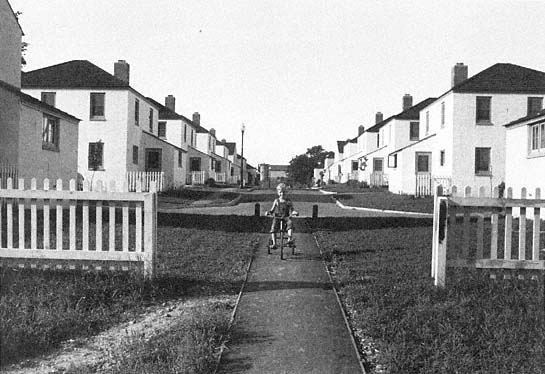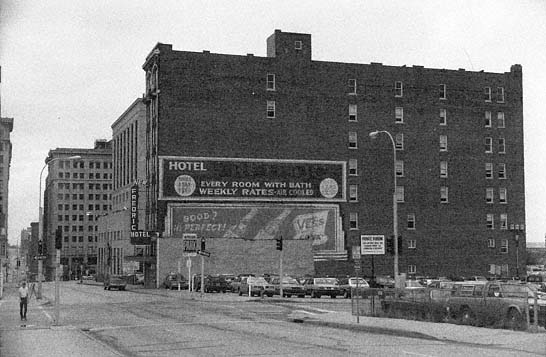Deliberate Ignorance as a Professional Strategy
The early activities of the San Francisco Housing Association and the CIH demonstrated that learning about a problem often brought administrative power to

Figure 8.14
The New Deal housing reformer's minimum. The model town of Greendale, Wisconsin, photographed
in 1939, just after its construction.
new urban professionals. Later experts proved that ignorance could also have power: if urban experts deliberately created ignorance about a problem, that issue was assured relative oblivion—assuming there was no political activism on the part of the public. Perhaps it was his observance of similar effects of nineteenth-century government administration that led Goethe to write, "There is nothing more frightening than active ignorance."[62]
One sociologist's research in 1948 uncovered the process of deliberate ignorance to be notably at work in regard to single people and hotel life. Arnold Rose exhaustively surveyed the literature about the living arrangements of single people, especially in the settings of rooming houses and cheap lodging houses. From a low point before 1890, interest gathered until 1915 and relapsed into disinterest after 1920.[63] San Francisco's Progressive Era interest closely matched Rose's model. The State Tuberculosis Commission had inspected the city's hotels carefully; the earliest CIH surveys in the city included problem hotels and led to the state's hotel acts of 1913 and 1917. The drop in California interest after 1920 matched the national trend.[64]
Idealistic studies of families and children and the simultaneous omission of single adults also helped to allow the growing professional disinterest in nonfamily households. As usual, Veiller serves as both exemplar and partial cause. At no time was he notably interested in single people or their housing. On a visit to San Francisco in 1902, he reported that the poorest living quarters were the "homes of the longshoremen, situated near the docks, . . . containing two families each." To be near the docks and those duplexes, Veiller had to walk past blocks full of rooming houses and hotels for single longshoremen, but he apparently did not notice them. He concluded, in fact, that San Francisco had no tenement problem at all.[65] In 1903, Veiller and Deforest's massive two-volume collection of articles about America's housing problems contained only a few passing mentions of hotels. In his 1910 book, Housing Reform , Veiller mentions hotels only once, in the context of high-class hotels. His chapters on housing investigations were written only for apartments and single houses.[66] In short, as Veiller and others framed the urban housing concerns of the United States, they purposely left hotels out of view.
Activists elsewhere reproduced the blind spots in the New York models. When San Francisco finally appointed two housing inspectors for the Board of Health, the commissioners dubbed them "tenement house inspectors," thereby setting a narrow focus for them. Similarly, reports by the San Francisco Housing Association dodged the subject of hotels. When they investigated housing problems in Telegraph Hill and North Beach, San Francisco's reformers incredibly made no mention whatsoever of workers' rooming houses or hotels, which dominated the Broadway border of both districts. The later work of the CIH was similarly silent in this regard.
Even during the positive wave of interest that crested in 1915, for every large book on family housing, usually only a slim article appeared about nonfamily people. By the 1920s, that token measure dwindled as well.[67] Consider how Edith Abbott discussed 60,000 men of downtown Chicago in her exhaustive summary of Chicago housing surveys undertaken between 1910 and 1936:
There are, of course, the large numbers of those who live in cheap hotels, boarding houses, and "flops"—the casuals who come and go in the "flophouses" near the loop. . . . No attempt will be made at this point to discuss the
hotels or shelters for single men since our interest here lies largely in the housing of families and in the tenements where families live.[68]
Abbott had a purely negative impression of hotel life derived from skewed samples. For her chapter on Chicago rooming houses, she relied on a 1929 thesis about a sixty-unit residential hotel; the thesis was based only on the five to ten families from the building (over five years' time) who had come to the United Charities offices for assistance. The thesis was based on the worst possible cases.[69]
Even that bastion of social statistics, the U.S. Census, largely ignored hotels—both as an industry and as homes. Although hotels ranked fourth or fifth in income and number of workers among American businesses in 1905, the editor of a hotel journal expressed his general frustration:
We have no figures, no statistics, no official rating . . . which we might compare with other industries. Our government which counts every mule, every bushel of wheat, which has figures on every possible production, has nothing to relate regarding legitimate hotel keeping.[70]
The editor was complaining that the census office reported only the number of hotel keepers, not distinguishing size or type of hotel. Census takers, of course, did enumerate individual hotel residents as part of the U.S. population. But the census staff has never aggregated those statistics to show accurately how many people have lived in hotels. The figures typically mix residents of hotels and rooming houses into those in other "dwelling units," or with military personnel, indigent residents of institutions, or residents of convents, monasteries, dormitories, or sorority houses.[71] These figures, at best, can supply only rough estimates. In 1930, the U.S. Census Bureau did publish a special report on the hotel industry, but it did not discuss permanent residents.[72]
Hotels continued to be out of focus for housing activists and city planners in the 1930s. In the seven report volumes of Hoover's national conference on housing, neither single-room housing nor the housing of single people was mentioned. The hundreds of excellent New Deal studies, reports, outlines, discussions, and conferences about housing problems included only very negative information about single-room housing, mostly on so-called homeless men, their urban flophouses and
shantytowns, and rural CCC and FSA labor camps.[73] Academic coverage of hotel housing continued to be virtually nil in the 1930s.[74]
As the depression wore on and instructions came more efficiently from Washington, D.C., instead of from local officials, New Deal reports—especially real estate reports—became increasingly conservative about including hotel information. The remarkable series of real property surveys is the most salient example. The first comprehensive real estate survey supported by federal funds was made in 1933 – 34 in Cleveland; most major cities followed suit in succeeding years. A revived San Francisco Housing Association had surveyed the Western Addition in 1933; other partial surveys were done of San Francisco in 1934 and 1936 to identify sites for clearance and renewal. These reports were done under municipal rather than federal guidelines, and all of the reports prominently featured hotels as part of the city's housing stock.[75] These early works were overshadowed by the much more ambitious citywide 1939 Real Property Survey of San Francisco.
San Francisco's 1939 Real Property Survey and its subsequent influence provide a stunning case of how deliberate ignorance can be created and perpetuated. For the survey, a small army of field enumerators collected room-by-room data about hotels as well as door-by-door counts of apartments, flats, and houses. However, following federal guidelines, the office staff then systematically excised hotels from the survey's compilations. In their summary volume, the staff devoted only 7 out of 253 pages of discussion and tables to San Francisco's residential hotels.[76] The meticulously detailed survey had found that one-third of both substandard dwelling units and ill-housed people of San Francisco were in hotels, but the staff hid this fact in procedural tables buried in the Appendix of the report volumes. The survey directors ignored the state's long-standing legal definition of hotels, split hotel housing into several different and conflicting categories, admitted that their survey of the 34,000 "primarily one-room dwelling units" in hotels was "an incomplete coverage for this type of permanent residence," and mildly suggested further study.[77] The 1940 U.S. Census of Housing (the first national census of housing) repeated the problems and biases of the real property surveys. The census collected information about hotels but annihilated that information in its reporting techniques.[78]
In 1941, the San Francisco Housing Authority reviewed the Real Property Survey and did ferret out comments about the city's nearly

Figure 8.15
Statistically invisible hotel. Using 1930s guidelines for real property surveys, the long and narrow
Hotel Frederick in Kansas City contained no housing units. Note "weekly rates" promoted on the sign.
five hundred hotels. The housing staff assumed the hotels had only recently been "converted from commercial to residential uses," erroneously supposing that all had been transient accommodations before the depression. Sounding a great deal like Edith Abbott, the San Francisco planners wrote that "due to the fundamental differences between these two types of dwelling units [hotels versus houses and apartments], the primary analysis and report on housing in San Francisco will exclude the dwelling units in converted hotel structures" (fig. 8.15).[79]
The basic data of the 1945 Master Plan for San Francisco—including its recommendations on land clearance—came directly from the 1939 Real Property Survey . The San Francisco Planning Commission incorrectly described the building types in the city's worst redevelopment areas as "generally three or four story flats or, as in Chinatown, tenement-type apartments."[80] The units in Chinatown were largely SRO hotels. In the South of Market, hotels were also a major share of the building fabric. Similar gaps of logic and description continued to appear in subsequent reports. The vacuum of information was such that in 1966, when William Wheaton and other housing experts compiled an authoritative 470-page series of readings on urban housing,
the only words on residential hotels or housing for single, transient, or unattached people were in a five-page reprint of a twenty-year-old article by Arnold Rose.[81] Until the 1970s, the well-meaning planners of San Francisco, like their contemporaries in other cities, continued their policy of carefully not studying hotels.
The omission in San Francisco's urban surveys of single-room housing units and the people who lived in them (rich or poor) seems incredible in the light of their downtown prevalence. Planners and officials in hundreds of other cities repeated the omission. This was neither oversight nor negligence but active repudiation. As Rose had warned in 1948, it was as if the people in hotel settings "were thought to be nonexistent, or at least entirely impoverished so that they could not expect anything by way of adequate housing."[82] He warned that this housing and its population presented an important problem, but his call to action fell on deaf ears. Rose became the Cassandra of today's single room occupancy crisis.
Because of the definitions of a proper American home, apartment units and their renters fared better. From the turn of the century, apartments were carefully watched and carefully counted as important resources. Writers and citizens heralded the building of apartment units as important housing additions to the city. The same was not true for most single-room options. Cheap apartments became a public concern and a public necessity; cheap hotels, if they were noticed at all, remained a public nuisance.